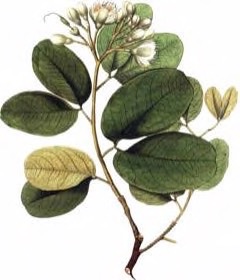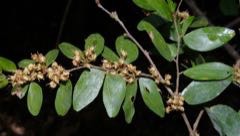 |
|
http://www.edibleplants.org |
 |
| Rodolfo Vásquez Tropicos.org |
Translate this page:
Summary
Hymenaea martiana is an evergreen tree that can be found in South America. It has a dense, wide-spreading crown and short bole of up to 90 cm in diameter. It reaches a height of 18 m. It is often harvested from the wild for its high quality timber. The fruit is edible when raw. It has a white pulp. The wood is heavy to very heavy, hard to very hard, elastic, durable, and resistant to insect and termites attacks. It has a wide range of applications including for high class furniture, cabinet making, construction, etc.
Physical Characteristics

 Hymenaea martiana is an evergreen Tree growing to 13 m (42ft) by 10 m (32ft) at a slow rate.
Hymenaea martiana is an evergreen Tree growing to 13 m (42ft) by 10 m (32ft) at a slow rate.
See above for USDA hardiness. It is hardy to UK zone 10.
It can fix Nitrogen.
Suitable for: light (sandy), medium (loamy) and heavy (clay) soils, prefers well-drained soil and can grow in nutritionally poor soil. Suitable pH: mildly acid, neutral and basic (mildly alkaline) soils. It cannot grow in the shade. It prefers moist soil.
UK Hardiness Map
US Hardiness Map
Synonyms
Cynometra martiana (Hayne) Baill. Hymenaea sellowiana Hayne
Plant Habitats
Edible Uses
Edible Parts: Fruit
Edible Uses:
Fruit - raw[625 ]. The white, mealy pulp surrounding the seeds is eaten[625 ]. The semi-cylindrical seedpod is up to 15cm long and 6cm wide, containing 5 - 8 seeds[625 ].
References More on Edible Uses
Medicinal Uses
Plants For A Future can not take any responsibility for any adverse effects from the use of plants. Always seek advice from a professional before using a plant medicinally.
None known
References More on Medicinal Uses
The Bookshop: Edible Plant Books
Our Latest books on Perennial Plants For Food Forests and Permaculture Gardens in paperback or digital formats.

Edible Tropical Plants
Food Forest Plants for Hotter Conditions: 250+ Plants For Tropical Food Forests & Permaculture Gardens.
More

Edible Temperate Plants
Plants for Your Food Forest: 500 Plants for Temperate Food Forests & Permaculture Gardens.
More

More Books
PFAF have eight books available in paperback and digital formats. Browse the shop for more information.
Shop Now
Other Uses
Furniture Wood
Other Uses: The heartwood varies from purple-brown or orangey-brown to red-brown, with slight veins; it is clearly demarcated from the 3 - 12cm wide band of sapwood. The texture is medium; the grain straight or interlocked; there are slight internal stresses. The wood is heavy to very heavy; hard to very hard; elastic; durable, even in contact with the soil, being resistant to fungi, dry wood borers and termites. It seasons normally, with only a slight risk of checking and distortion; once dry it is moderately stable to stable in service. The wood has a fairly high blunting effect, stellite-tipped and tungsten carbide tools are recommended; nailing and screwing are good, but require pre-boring; gluing is correct for interior use only, but needs to be done with care because of the density of the wood. The wood has a wide range of applications, including for high class furniture, cabinet making, construction, heavy duty flooring, ship building, carving, turnery, tool handles etc[386 , 625 , 848 ].
Special Uses
References More on Other Uses
Cultivation details
Grows best in a sunny position[625 ]. Grows in the wild on moist, clay soils[625 ]. The plant has a slow rate of growth, even when small[625 ]. Although many species within the family Fabaceae have a symbiotic relationship with soil bacteria, this species is said to be devoid of such a relationship and therefore does not fix atmospheric nitrogen[755 ].
References Carbon Farming Information and Carbon Sequestration Information
Temperature Converter
Type a value in the Celsius field to convert the value to Fahrenheit:
Fahrenheit:
The PFAF Bookshop
Plants For A Future have a number of books available in paperback and digital form. Book titles include Edible Plants, Edible Perennials, Edible Trees,Edible Shrubs, Woodland Gardening, and Temperate Food Forest Plants. Our new book is Food Forest Plants For Hotter Conditions (Tropical and Sub-Tropical).
Shop Now
Plant Propagation
Seed - it has a hard seedcoat and benefits from scarification before sowing to speed up and improve germination. This can usually be done by pouring a small amount of nearly boiling water on the seeds (being careful not to cook them!) and then soaking them for 12 - 24 hours in warm water. By this time they should have imbibed moisture and swollen - if they have not, then carefully make a nick in the seedcoat (being careful not to damage the embryo) and soak for a further 12 hours before sowing. Sow the treated seed in a partially shaded position in individual containers. A germination rate in excess of 50% can be expected from treated seed, with the seed sprouting within 15 - 30 days[625 ].
Other Names
If available other names are mentioned here
Copal, jatobá, Jatoba-miudo
Native Range
SOUTHERN AMERICA: Brazil (Alagoas, Bahia, Ceará, Goiás, Mato Grosso, Minas Gerais, Pernambuco), Paraguay
Weed Potential
Right plant wrong place. We are currently updating this section.
Please note that a plant may be invasive in one area but may not in your area so it's worth checking.
Conservation Status
IUCN Red List of Threatened Plants Status : This taxon has not yet been assessed

Growth: S = slow M = medium F = fast. Soil: L = light (sandy) M = medium H = heavy (clay). pH: A = acid N = neutral B = basic (alkaline). Shade: F = full shade S = semi-shade N = no shade. Moisture: D = dry M = Moist We = wet Wa = water.
Now available:
Food Forest Plants for Mediterranean Conditions
350+ Perennial Plants For Mediterranean and Drier Food Forests and Permaculture Gardens.
[Paperback and eBook]
This is the third in Plants For A Future's series of plant guides for food forests tailored to
specific climate zones. Following volumes on temperate and tropical ecosystems, this book focuses
on species suited to Mediterranean conditions—regions with hot, dry summers and cool, wet winters,
often facing the added challenge of climate change.
Read More
Expert comment
Author
Hayne
Botanical References
1
Links / References
For a list of references used on this page please go here
A special thanks to Ken Fern for some of the information used on this page.
Readers comment
| Add a comment |
|
If you have important information about this plant that may help other users please add a comment or link below. Only comments or links that are felt to be directly relevant to a plant will be included. If you think a comment/link or information contained on this page is inaccurate or misleading we would welcome your feedback at [email protected]. If you have questions about a plant please use the Forum on this website as we do not have the resources to answer questions ourselves.
* Please note: the comments by website users are not necessarily those held by PFAF and may give misleading or inaccurate information.
To leave a comment please Register or login here All comments need to be approved so will not appear immediately.
|
Subject : Hymenaea martiana
|
|
|
|